- This article is about the deity worshiped by the Order. For the enemies representing this figure, see Alessa's Dream, God (boss), Incubator or Incubus. For this being in the comic universe, see Samael (comics).
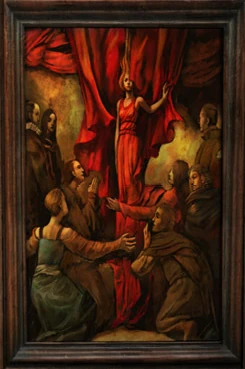
A painting depicting God surrounded by people, from Silent Hill 3.
God, also known as the Creator of Paradise, Lord of Serpents and Reeds, the Holy Mother and Samael (the name of a demon given by the cult's opponents), is the mysterious sun goddess worshipped among many members of the Order and has played a major antagonistic role throughout the Silent Hill series. She is often represented as an orange-haired woman draped in red robes. Though She is called God and is often given titles of reverence to apply as such, She is not the deity of any real-world religions.
The goals of many of the series antagonists revolve around initiating Her rebirth, hoping to bring about the Apocalypse, and through the destruction of humanity, a promised Paradise. She is the central deity of the Holy Woman sect.
Although God plays a significant role in the Order's goals and ambitions, it is unclear as to what exactly the nature of "God" is, and as to how She's connected with the supernatural occurrences of Silent Hill. God could be seen as a symbol for the mysterious force that inhabits the world and is responsible for the horrific occurrences of the series. God's creations, actions, and desires are more suggestive of a demon and/or malevolent dark goddess rather than a benevolent deity of light.
When a physical manifestation of God is presented, She acts like a powerful monster, rather than an intelligent being. It is possible, considering the malevolent nature of the Order, that God is actually a powerful kind of monster that the cult worships, and is merely represented as a woman to make it seem less hostile and threatening. This is supported by the fact that Valtiel, depicted as a monster, is worshiped by the Order as one of God's "angels".
Myth
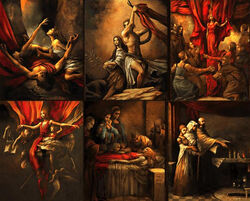
The Order's paintings of God
Presented in Silent Hill 3, these myths help establish backstory for God. They can also be heard in "Sun", track 22 from the game's soundtrack.
Birth and creations
According to the Order's beliefs, humanity existed before God. Here, people knew only pain and hatred. Seeking salvation from the world around him, a man offered a prayer and a serpent to the sun. A woman, offering prayer and a reed to the sun, asked for joy. Taking pity on a world consumed by sadness, the pleas of these two people breathed life into God, and from them, She was born.
The world, as it was then, had no understanding of linear time. So, the first thing God did was establish a linear, measurable time, separating it into night and day. After this, She outlined to humanity the road to salvation and gave the world joy. Since people weren't able to die, God took away their immortality. The reason for this was so people could know the freedom that comes from death.
Her next act was the creation of other deities and angels, those most notable among them being Lobsel Vith, the Yellow God, and Xuchilbara, the Red God. This was done so She would have help in leading humanity to follow Her in obedience. Her final gift to the world would be Paradise.
Paradise and death
With Her creation of the world completed, God set about creating a place where people would be eternally happy. With its creation, though, God's strength was used up and She collapsed. With Her last breath, She promised She would come again. She is then said to have "returned to the dust".
The Crimson Ceremony
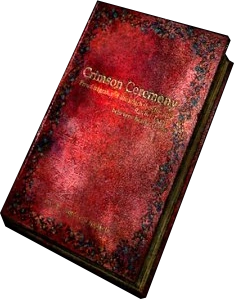
The Crimson Ceremony
The Crimson Ceremony, an item from Silent Hill 2 necessary to obtain the "Rebirth" ending, is a work written as though spoken by a figure who holds itself to be of some importance. The speaker is never identified beyond the moniker of The Crimson One, though the usage of the text in such a manner as implied by the Rebirth ending seems to indicate that it comes from a source of divinity with sway over life, death, and rebirth. Xuchilbara, the Red God, might be the deity speaking through these scriptures, with "The Crimson One" being one of the deity's alternate names. Valtiel, if he is not Xuchilbara or the Yellow God Lobsel Vith, could also be a likely candidate for the real identity of the "Crimson One", since he has been noted to have sway over rebirth; Valtiel has been seen to symbolically display this authority over rebirth through the turning of valves. The deity that James Sunderland seems to want to conjure during the enactment of this ritual is therefore left to speculation, with no one single god or powerful being singled out as the one whose power is necessary to revive Mary Shepherd-Sunderland.
Resurrection
The people of the Holy Woman sect believed God would appear again one day, and as such, members of the Order have attempted to hasten her arrival; notable attempts are summarized below.
Dahlia Gillespie
By performing an unnamed ritual in her own house, Dahlia was able to let her daughter, Alessa Gillespie, carry God within her. Before the ritual could be completed, Alessa's soul fractured, ruining Dahlia's plans. Alessa, although a child, was nevertheless slightly aware of her mother's insidious hopes and deliberately severed her soul in the desire to somehow still feel happiness. This missing piece of Alessa manifested itself as Cheryl. Before completion, the ritual was interrupted by Travis Grady, and Alessa was left severely burnt and disfigured, yet still surviving as a side effect of either the ritual or a second incantation performed by the Order. Travis made a hasty attempt to get what should have been a terminally burnt child to Alchemilla Hospital. Desperate to have her daughter made whole so the ritual could be concluded, Dahlia cast a spell that would in time draw back the missing half (Cheryl) to Silent Hill via the child's mysterious will.
When the two halves were made whole in the events of the first game, God's manifestation as either Incubator or Incubus was briefly brought into existence, this existence being terminated soon after by Harry Mason.
Claudia Wolf
The fetus of "God" that Heather dispelled.
At the end of Silent Hill, Alessa, as the Incubator, gives Harry a baby. The Order attempted to kidnap the baby, who is later revealed to be a reincarnation of Alessa, and continue the ritual. However, Harry fought back and killed the cult member that attempted this, as mentioned in Silent Hill 3. Harry and the child went into hiding, renaming the little girl Heather Mason and dyed her hair blonde.
Seventeen years later, during Silent Hill 3, Heather was made to realize by a priestess of the Order, Claudia Wolf, who attempted to nurture God using hatred, that she still carried God within her. Heather used Aglaophotis to expel God. As a result, she vomited God as a blackened fetus, but Claudia ingested God's fetus and violently birthed God herself. Heather defeated the physical manifestation of God, just like her father Harry did seventeen years ago.
Walter Sullivan
Another ritual, the 21 Sacraments, was a back-up plan in case Dahlia's plan failed. Dahlia told Walter Sullivan as a child about the ritual of the 21 Sacraments. He planned on using the ritual to bring his mother back to life, which may mean that Dahlia could have lied about the ritual so that Walter would carry it out. It's thought that if Walter did carry out the ritual, his mother would not have been brought back to life and Dahlia's plan would have worked. Henry Townshend defeated Walter during the events of Silent Hill 4: The Room, preventing his and Eileen Galvin's death, and ending the ritual in the process. Eileen, "The Mother Reborn", may have been the planned carrier for God as a replacement for Heather.
Lesser gods and angels
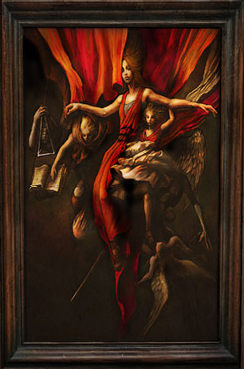
God and attending angels.
There came a time when God felt she needed assistance in holding sway over humanity. To accomplish this end, she was said to have created many lesser gods and angels. Among them were:
Lobsel Vith, referred to as the Yellow God in the Myth 4: Creation text, was said to have been created by God as an assistant to her. Little canonical information exists on Lobsel Vith, though it has been theorized that it may be Valtiel or an entity alike.
Xuchilbara, called the Red God, is mentioned in the same text. As with Lobsel Vith, no concrete evidence exists that can tie Xuchilbara to an established figure in the Silent Hill mythos, though it is theorized to be Alessa's Dream.
Valtiel, often times cited as the closest being to God, is another being created by God. His role appears to be one of protection, as seen through his constant vigil over Heather Mason in Silent Hill 3 when he drags her body away after she dies in the Otherworld to revive her. However, he may simply be protecting the growing god she carries with no real concern for Heather's welfare. Taking the Sect of Valtiel into consideration, it would seem he is also worshiped, and the town's early executioners modeled their attire after Valtiel's. The name "Valtiel" is also derived from the word "valet", which denotes Valtiel's position as the caretaker or attendant to God.
Nature of God
Through the course of the Silent Hill series, God, as a being, is rarely explored in depth. Instead, players are shown the Order acting in Her stead, following what they consider to be Her commands. Through their actions, God is portrayed as a strict being, demanding complete faith and devotion from Her servants, as well as various forms of sacrifices. In exchange, She seems to grant her followers rather bizarre powers, an example of which is Claudia Wolf and her ability to conjure shifts between worlds. By examining The Crimson Ceremony that is presented above, if that work can indeed be attributed to God, She is painted not only as strict, but vengeful as well, promising wrath and bitter vengeance, presumably on those who fail to heed Her call.
In Silent Hill: Homecoming, God is presented as a malicious being. 150 years ago, the founders of Shepherd's Glen sought to separate themselves from the Order for unknown reasons. Fearing retribution from God, however, those four families entered into a pact with their divine patron, the Order's deity. In exchange for the life of one child from each of the four families every fifty years, they and their new home would be spared from Her wrath. When Alex Shepherd accidentally drowns and kills Joshua Shepherd, the pact is broken and Shepherd's Glen becomes entwined with both the Fog World and the Otherworld, as part of Her wrath to the now "damned" town.
God's nature as a benevolent deity is often called into question. God's behaviors and actions are often violent and inhumane, exemplified by Her interests in torturing lost souls and punishing those whom She feels require it. She appears to be much more closely related to the common definition of a demon rather than a god. In Silent Hill 3, Heather even asks Vincent Smith if God could be considered the devil, to which he responds, "Whichever you like." God seems to feed on suffering, as all of Her rituals and birthing sacraments focus around both physical and mental agony. It often seems that God has little interest in preserving members of the Order unfortunate enough to be caught in the Otherworld, as members exhibit a fear of it and the mangled bodies of Order members are not an uncommon sight. God's intelligence may also be questioned, as all of Her incarnations act no different from the other creatures that inhabit the Otherworld.
Another possibility is that God is in fact a construct of the combined beliefs and perceptions of the people involved, much like the monsters may be as well. If this is the case, then it may be that there are no actual supernatural beings influencing the town, only an unexplained phenomenon which merges reality with the subconscious thoughts of human beings. This could explain why God appears as a creature which is as vulnerable to physical damage as most other monsters.
Influence of real-world religions
No single religion can be listed as an influence for the Order's deity, and, by proxy, the Order's teachings and rituals themselves also have multiple influences. Hiroyuki Owaku cites the origins of Christianity, Japanese folklore and Aztec rituals as inspirations for the faith as detailed in the series.[1] The faith also bears a striking resemblance to occultism, demonic and Satanic worships.
A distinguishing trait sets the Order apart from other religions, in regards to its mythology. The Order proposes that humans had a history, if a jumbled, non-linear one, before God came into being, and that God only came into existence with the help of humans. This is contrary to every mainstream religion, in which the reverse is true. This may mean that the God in Silent Hill was artificially a human-made rather than an actual deity. Unlike the majority of monotheistic religions, God is explicitly referred to as female and is never called "goddess". The name "God", in English, is masculine, and this leaves room for the possibility that their god may be a hermaphrodite, especially when its various incarnations are considered, such as the Incubus.
Trivia
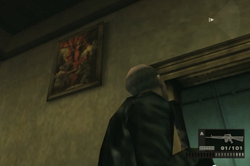
Easter egg showing a painting of God found in the chapel in Metal Gear Solid 3.
- Among the various documents that are found in the chapters of the series, there is one present in Silent Hill: Downpour entitled Early Residents: The First People. There it is written that anthropologists had discovered and found some artifacts that belonged to a tribe of Native Americans who once lived and made a home in Silent Hill, in an area near the Devil's Pit. The remains found were used for ceremonial rituals held in Silent Hill for the deity called "Kwekwaxawe" ("The Raven" or "Raven"). This could be the original name of Silent Hill's god, and it is demonstrated and revealed that the tribe who called the region "The Place of Silenced Spirits" before it was later renamed "Silent Hill" were known as the Kwekwaxawe Kanesda ("Nest of the Raven").
- There's a painting of God in Metal Gear Solid 3.
